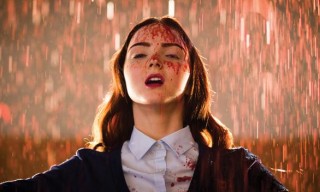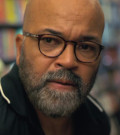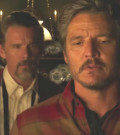 Lily Cole talks about her new vampire flick, The Moth Diaries, co-starring Scott Speedman.
Lily Cole talks about her new vampire flick, The Moth Diaries, co-starring Scott Speedman.
When you think about teenage girls and vampires, you naturally think about the “Twilight” series. But Canadian director Mary Harron, who has helmed such provocative films as “American Psycho” and “The Notorious Bettie Page,” is hoping to put a darker spin on growing up in her upcoming film of Rachel Klein’s popular 2002 novel “The Moth Diaries.”
“I like the idea that there are dark things out there, which is kind of true,” she said during a visit to the Montreal set. “It’s an exaggerated, supernatural version of all adolescence, where you always have to fight your way out. Every teenage girl somehow has to fight her way out and reach the adult world.”
“The Moth Diaries” book is told from the perspective of a teenage student at the all-girls private school, Brangwyn Hall. The unnamed narrator begins to lose her grip on reality when her best friend, Lucy, becomes enamoured of a new student named Ernessa. Ernessa is European, pale-skinned, shuns meals with the rest of the girls, and, as Lucy begins to weaken and lose weight, the narrator begins to suspect that Ernessa is also a vampire. Whether or not that is the case is never revealed in the book, a key detail Harron preserves in her script.
“I think the ambiguity of... the script and the book was really interesting when we all read it,” says Toronto actress Sarah Gadon (“Leslie, My Name Is Evil”) who plays Lucy. “Was this supernatural or is this the hysterical behaviour of young teenage girls? And so I think that to categorize it as a blatant vampire film almost doesn’t do the film justice.”
In the movie, the nameless narrator has become Rebecca. Playing her is 19-year-old Irish actress Sarah Bolger (“In America,” TV’s “The Tudors”). But should audiences trust Rebecca? Bolger won’t say but insists that her character trusts herself.
“It’s completely depicted as a 17-year-old girl’s point of view. You can believe it as much as you like. It’s through her eyes as she believes it to be true. Everything you see, she fully believes.”
Playing her rival, Ernessa, is British model Lily Cole, 22, who has mostly given up catwalks these days in favour of soundstages (she played Christopher Plummer’s daughter in Terry Gilliam’s recent film “The Imaginarium of Doctor Parnassus”) and classrooms (after finishing “The Moth Diaries,” she will return to her art history studies at Cambridge). For her part, she doesn’t see Ernessa as a villain at all.
“The idea of a mirror comes to me,” she says of her character. Instead Ernessa is “a mirror of lots of other people’s projections, whether it’s the romantic relationship I develop with Lucy’s character or the idea I like of being either an alter ego to Rebecca’s character or a very manipulative [influence]. Either concept works for me.”
Harron, who spent nearly five years working on the script, with Klein providing notes on each successive draft, was intrigued by the complex relationships between its adolescent female characters -- a complexity rarely seen in mainstream films.
“I remembered in my own life the intense, crazy friendships girls have in adolescence, and that has always interested me. And this love that they have for each other that’s very intense... There’s almost no word in English that we have to describe that kind of love. You can’t even say it’s platonic love. It’s almost a romantic love, but it’s between young girls. It’s before they’re ready for boys, in a way. It’s almost like their rehearsal, and they’re not really ready for the big world, and so they throw a lot of their emotions into their relationships with each other. I think that’s a thing that many, many girls do.”
The combination of teenagers, vampires and obsessive love brings to mind another recent film series. But while co-producer Ronald Gilbert admits to being happy to surf the recent vampire film trend (“Sounds perfect,” he says in a separate interview), Harron is channelling other influences, included “Rosemary’s Baby,” Hammer Horror films, Bram Stoker’s original “Dracula” novel and Joseph Sheridan Le Fanu’s infamous lesbian vampire novella “Carmilla.”
“’Twilight’ is a romance. It’s not really a horror movie,” she says. “It’s a romantic fantasy and is really good at that. But I was interested in having something that was scarier and I guess darker, more disturbing.”
Part of that darkness comes from dealing with the very real concerns teenage girls have with their body image. In the novel, the students of Brangwyn are constantly talking about weight and how their bodies are changing. Rebecca, meanwhile, worries that Lucy’s sudden ill health is caused by Ernessa draining her friend’s blood when the more obvious answer is that Lucy simply isn’t eating. Harron says she has tried to preserve this aspect of the novel in her film.
“I love the way that Rachel Klein’s novel took all these things of the adolescent girl and turned them into something supernatural; they were kind of amplified through the supernatural. So that Lucy, as she wastes away, the way I take it, everyone thinks it’s anorexia, but who knows?”
When asked about the link between anorexia and modelling, Cole declines to be drawn in. (“It’s not my place to discuss the fashion world’s relationship with that problem”). Instead she points out that anorexia is a concern for all girls, not just models.
“I found that that’s been an issue I’ve seen more prevalently in school situations. It is a very big problem. I’m more interested in that issue being a social problem, and it’s explored a lot in Mary’s script, and I think that’s an important part of that dialogue with adolescence as a theme.”
-By Sean Plummer - MSN.ca







Comments: